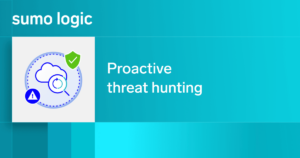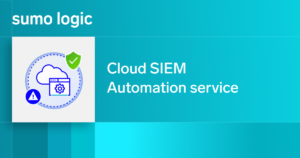
As budget cycles increasingly force teams to tighten their belts, proving the value of vital technology is key. It’s not enough to showcase how the security operations center (SOC) is improving security posture and defending against threats, you also need to highlight how this boosts ROI.
As highlighted in an IDC webinar and white paper, organizations using Sumo Logic have experienced an exceptional return on investment and a rapid payback period. They achieved an impressive 376% three-year ROI with a payback period of just four months. This substantial financial return is driven by multiple factors, including improved security, operational efficiency, and troubleshooting capabilities.
Companies benefit from faster response times to security threats and reduced downtime, translating into both direct cost savings and significant business gains. Chief Information Officers (CIOs) and Chief Information Security Officers (CISOs) face the daunting task of staying ahead of malicious actors as cyber threats become increasingly sophisticated and protecting their organization’s digital assets, all while protecting their budgets, too.
The SIEM as the heart of the SOC
An effective cybersecurity strategy must incorporate and put an emphasis on technologies capable of ingesting and analyzing large volumes of unstructured data in order to ensure potential threats are caught early and often. The SOC must leverage advanced technologies, in particular a tool for comprehensive threat detection, investigation, and response–specifically, they need a security information and event management (SIEM) solution.
Speaking at our “Harnessing a modern SIEM to build a resilient and intelligent SOC” webinar, Michelle Abraham, Research Director for Security and Trust at IDC, underscored the persistent challenges faced by organizations today. Notably, approximately 60% of organizations report experiencing significant breaches resulting in downtime within a 12-month period – a statistic that, perhaps disturbingly, has remained steady over the past few years.
One contributing factor is undoubtedly the complexity involved in managing SIEM systems. Steep learning curves, partial access to the right data sources (or leaving some essential data sources on the cutting room floor due to cost concerns), and difficulty updating the SIEM with the most recent threat intelligence all compound the difficulty of effectively employing a SIEM for securing an organization. Abraham goes on to highlight the necessity of automation and leveraging AI/ML as critical factors in staying ahead of evolving threats.
In essence, the SIEM is the tip of the spear when it comes to safeguarding against advanced threats. Sumo Logic enables organizations to detect, respond to, and mitigate security threats with unprecedented speed and accuracy. Security teams reported a 65% improvement in their ability to detect threats and a 60% faster response time to incidents. The improved detection and response times, coupled with a 45% reduction in the overall duration of security breaches, drastically improves overall organizational resilience.
By streamlining monitoring across all applications (wherever in the environment they are hiding) and consolidating key data into a unified platform, Sumo Logic empowers both security and DevOps teams to engage proactively, ensuring the safety and performance of critical business functions.
Point solutions vs. centralized platforms for breaking down silos
James Morris, Vice President of Cyber Services and Technology at Security Resource Group, emphasized how the growing trend toward creating more collaborative teams by working with unified tools can be leveraged to address the inefficiency of managing siloed security tools and the benefits of having all teams speaking a “common language” within a centralized system.
Chas Clawson, Field CTO at Sumo Logic, reinforced this view by discussing the significant efficiency gains realized when organizations implement modern cloud-based SIEM solutions. He pointed out that having a centralized platform not only enhances the cross-functional collaboration Morris outlined but also streamlines the process of correlating security signals, thereby reducing both the time and effort required for effective threat detection, investigation, and response.
One of the key advantages highlighted by Sumo Logic users is its ability to break down silos between IT, security, and development teams. By providing a unified view of operational and security data, Sumo Logic fosters better collaboration, making it easier for cross-functional teams to address issues quickly and effectively. This integrated approach not only improves productivity but also enhances customer satisfaction. With a 25% faster time to market for products and services, organizations that employ a centralized platform are better positioned to meet customer demands, deliver higher-quality experiences, and fuel innovation and growth.
Improving key security metrics
Our panelists agreed that measurement is crucial in cybersecurity, with mean time to detect (MTTD) and mean time to resolve (MTTR) being the key metrics SOC teams, CISOs, and organizational leadership as a whole need to be laser-focused on. As organizations need to continuously improve their security posture, Chas Clawson stressed the importance of vendors partnering with customers to make these metrics easily accessible and understandable, adding that a customer’s lack of visibility into these metrics is really a failure on the vendor’s part.
Michelle Abraham pointed out that proper correlation and analysis can significantly reduce investigation times, thus improving both MTTD and MTTR, but only if SOC teams have all relevant security data in one place. She highlighted that automation, enabled by centralized data, plays a crucial role in achieving these improvements.
A big piece of improving these metrics is reducing alert fatigue and improving alert fidelity. Behavioral analytics allow for more context-driven alerts, making it easier to identify true threats while minimizing distractions caused by false alarms. This approach not only improves detection accuracy but also enhances the overall efficiency of security operations.
Implementing the right security solutions can produce very real results, as Michelle Abraham highlighted based on IDC’s research into Sumo Logic customers.
“The organization saw a 65% reduction in their mean time to detect and a 60% reduction in their meantime to respond. So analysts were able to investigate 29% more incidents each day, which means that less of them are going unanswered or being ignored because there’s always something new.”
The business impact of risk reduction
“Security, unfortunately, is never a revenue-generating exercise,” said Clawson, “and we’re defending our budget at all times because, you know, it’s a cost center.”
This hits home for many security professionals who are often made to justify the expensive tools they rely on daily to protect their companies from cyber attacks and demonstrate and maintain regulatory compliance, often with unclear benefits to other organizational leaders. While risk reduction itself is the primary benefit, there are secondary benefits gained by reducing the time to detect and respond to threats, and organizations can avoid potentially catastrophic incidents that could result in significant financial losses.
“If you can detect a threat actor or an attack earlier, then you can avoid other things happening down the line,” added Michelle Abraham, “potentially you avoid having the threat actor exfiltrate data to then, you know, either encrypt it for ransom or blackmail so that it’s not released. Improving those aspects doesn’t stop the attack necessarily from happening to start with, but can improve the amount of time that it takes or help with a faster response. So the full attack isn’t carried out.”
Being able to correctly articulate this paradigm to leaders outside the security organization is an imperative function of CISOs.
Learn more about how leaders experience ROI based on improved MTTD and MTTR in the full IDC report.



